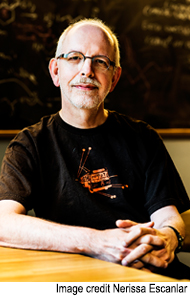研究者
Hut, Piet

- 氏 名
- Hut, Piet
- 役 職
- 主任研究者(参与、特任教授)
- 専門分野
- 宇宙物理学
- piet_at_elsi.jp
- TEL
- 03-5734-3414
プリンストン高等研究院 IAS: 609-734-8075 - LINK
主要業績/受賞歴
研究概要
My background is in astrophysics and before that in particle physics.
Much of my research has involved large scale simulations in stellar dynamics, especially that of star clusters. This resulted in a text book that I have co-authored with Douglas Heggie, The Gravitational Million Body Problem (Cambridge Univ. Pr. 2003). With Jun Makino, I have written an educational web site about introductory stellar dynamics, the Art of Computational Science (http://www.ArtCompSci.org).
One of the most widely used algorithms in stellar dynamics is the Barnes-Hut tree code, developed jointly with Joshua Barnes in 1986 (one of the very few times that Nature published an algorithm!). Other aspects of my work in stellar dynamics have been more theoretical.
Continuing the work on tidal interactions by George Darwin, the son of Charles Darwin, I derived analytic expressions for the evolution of stars and planets under tidal interactions. These are currently widely used for the study of exoplanets. Especially useful is the notion of pseudosynchronicity that I introduced in my earlier work.
I have also worked in broadly interdisciplinary research, starting with my work in astrophysics and particle physics in 1977, well before the term “astro-particle physics” was coined. Between 1984 and 1991, I published a number of papers on the connections between planetary dynamics and mass extinctions, in collaboration with geologists, paleontologists, chemists, nuclear physicists and others.
From 1994 on, I have organized a large number of small informal workshops that were even more broadly interdisciplinary, at the Santa Fe Institute, Stanford, Amherst College, and other places.
The Kira Institute (http://en.wikipedia.org/wiki/Kira_Institute) was established in 1997 to coordinate some of these activities.
In 2001 I returned to the topic of mass extinctions, this time with the aim not only to study it, but to prevent it from happening again, were possible. In that context, I was one of the founders of the B612 Foundation (http://en.wikipedia.org/wiki/B612_Foundation), which has become the first non-profit non-government organization to plan to launch a scientific satellite to provide early warning for asteroid impacts (http://en.wikipedia.org/wiki/Sentinel_%28space_telescope%29).
In 2002 I became the Head of the Program in Interdisciplinary Studies at the Institute for Advanced Study in Princeton. In 2012, I became a Principle Investigator of the WPI proposal in Japan that led to the foundation of the Earth-Life Science Institute, ELSI. Since then, I have shifted my main research focus to the study of the origins of life, with an emphasis on universal life aspects, where life is seen as the best example we currently know of truly complex systems.
Scoop independent newsインタビュー記事:
Piet Hut[Origins of Life and Herding Cats](22 March 2013)












